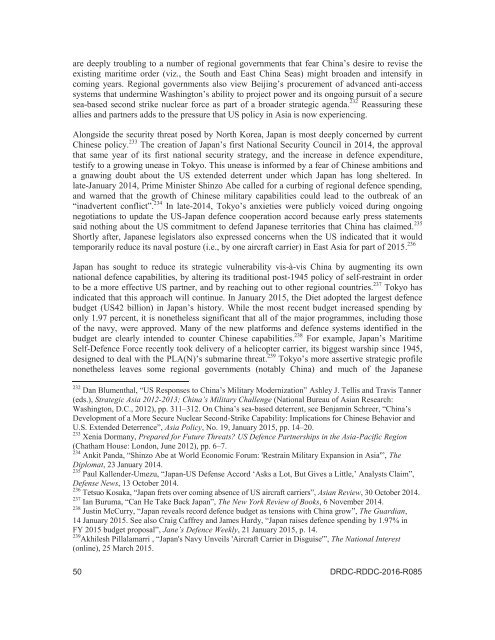You also want an ePaper? Increase the reach of your titles
YUMPU automatically turns print PDFs into web optimized ePapers that Google loves.
are deeply troubling to a number <strong>of</strong> regional governments that fear China’s desire to revise <strong>the</strong><br />
existing maritime order (viz., <strong>the</strong> South <strong>and</strong> East China Seas) might broaden <strong>and</strong> intensify in<br />
coming years. Regional governments also view Beijing’s procurement <strong>of</strong> advanced anti-access<br />
systems that undermine Washington’s ability to project power <strong>and</strong> its ongoing pursuit <strong>of</strong> a secure<br />
sea-based second strike nuclear force as part <strong>of</strong> a broader strategic agenda. 232 Reassuring <strong>the</strong>se<br />
allies <strong>and</strong> partners adds to <strong>the</strong> pressure that US policy in Asia is now experiencing.<br />
Alongside <strong>the</strong> security threat posed by North Korea, Japan is most deeply concerned by current<br />
Chinese policy. 233 <strong>The</strong> creation <strong>of</strong> Japan’s first National Security Council in 2014, <strong>the</strong> approval<br />
that same year <strong>of</strong> its first national security strategy, <strong>and</strong> <strong>the</strong> increase in defence expenditure,<br />
testify to a growing unease in Tokyo. This unease is informed by a fear <strong>of</strong> Chinese ambitions <strong>and</strong><br />
a gnawing doubt about <strong>the</strong> US extended deterrent under which Japan has long sheltered. In<br />
late-January 2014, Prime Minister Shinzo Abe called for a curbing <strong>of</strong> regional defence spending,<br />
<strong>and</strong> warned that <strong>the</strong> growth <strong>of</strong> Chinese military capabilities could lead to <strong>the</strong> outbreak <strong>of</strong> an<br />
“inadvertent conflict”. 234 In late-2014, Tokyo’s anxieties were publicly voiced during ongoing<br />
negotiations to update <strong>the</strong> US-Japan defence cooperation accord because early press statements<br />
said nothing about <strong>the</strong> US commitment to defend Japanese territories that China has claimed. 235<br />
Shortly after, Japanese legislators also expressed concerns when <strong>the</strong> US indicated that it would<br />
temporarily reduce its naval posture (i.e., by one aircraft carrier) in East Asia for part <strong>of</strong> 2015. 236<br />
Japan has sought to reduce its strategic vulnerability vis-à-vis China by augmenting its own<br />
national defence capabilities, by altering its traditional post-1945 policy <strong>of</strong> self-restraint in order<br />
to be a more effective US partner, <strong>and</strong> by reaching out to o<strong>the</strong>r regional countries. 237 Tokyo has<br />
indicated that this approach will continue. In January 2015, <strong>the</strong> Diet adopted <strong>the</strong> largest defence<br />
budget (US42 billion) in Japan’s history. While <strong>the</strong> most recent budget increased spending by<br />
only 1.97 percent, it is none<strong>the</strong>less significant that all <strong>of</strong> <strong>the</strong> major programmes, including those<br />
<strong>of</strong> <strong>the</strong> navy, were approved. Many <strong>of</strong> <strong>the</strong> new platforms <strong>and</strong> defence systems identified in <strong>the</strong><br />
budget are clearly intended to counter Chinese capabilities. 238 For example, Japan’s <strong>Maritime</strong><br />
Self-Defence Force recently took delivery <strong>of</strong> a helicopter carrier, its biggest warship since 1945,<br />
designed to deal with <strong>the</strong> PLA(N)’s submarine threat. 239 Tokyo’s more assertive strategic pr<strong>of</strong>ile<br />
none<strong>the</strong>less leaves some regional governments (notably China) <strong>and</strong> much <strong>of</strong> <strong>the</strong> Japanese<br />
232 Dan Blumenthal, “US Responses to China’s Military Modernization” Ashley J. Tellis <strong>and</strong> Travis Tanner<br />
(eds.), Strategic Asia 2012-2013; China’s Military Challenge (National Bureau <strong>of</strong> Asian Research:<br />
Washington, D.C., 2012), pp. 311–312. On China’s sea-based deterrent, see Benjamin Schreer, “China’s<br />
Development <strong>of</strong> a More Secure Nuclear Second-Strike Capability: Implications for Chinese Behavior <strong>and</strong><br />
U.S. Extended Deterrence”, Asia Policy, No. 19, January 2015, pp. 14–20.<br />
233 Xenia Dormany, Prepared for <strong>Future</strong> Threats? US Defence Partnerships in <strong>the</strong> Asia-Pacific Region<br />
(Chatham House: London, June 2012), pp. 6–7.<br />
234 Ankit P<strong>and</strong>a, “Shinzo Abe at World Economic Forum: 'Restrain Military Expansion in Asia'”, <strong>The</strong><br />
Diplomat, 23 January 2014.<br />
235 Paul Kallender-Umezu, “Japan-US Defense Accord ‘Asks a Lot, But Gives a Little,’ Analysts Claim”,<br />
Defense News, 13 October 2014.<br />
236 Tetsuo Kosaka, “Japan frets over coming absence <strong>of</strong> US aircraft carriers”, Asian Review, 30 October 2014.<br />
237 Ian Buruma, “Can He Take Back Japan”, <strong>The</strong> New York Review <strong>of</strong> Books, 6 November 2014.<br />
238 Justin McCurry, “Japan reveals record defence budget as tensions with China grow”, <strong>The</strong> Guardian,<br />
14 January 2015. See also Craig Caffrey <strong>and</strong> James Hardy, “Japan raises defence spending by 1.97% in<br />
FY 2015 budget proposal”, Jane’s Defence Weekly, 21 January 2015, p. 14.<br />
239 Akhilesh Pillalamarri , “Japan's Navy Unveils 'Aircraft Carrier in Disguise'”, <strong>The</strong> National Interest<br />
(online), 25 March 2015.<br />
50 DRDC-RDDC-2016-R085




